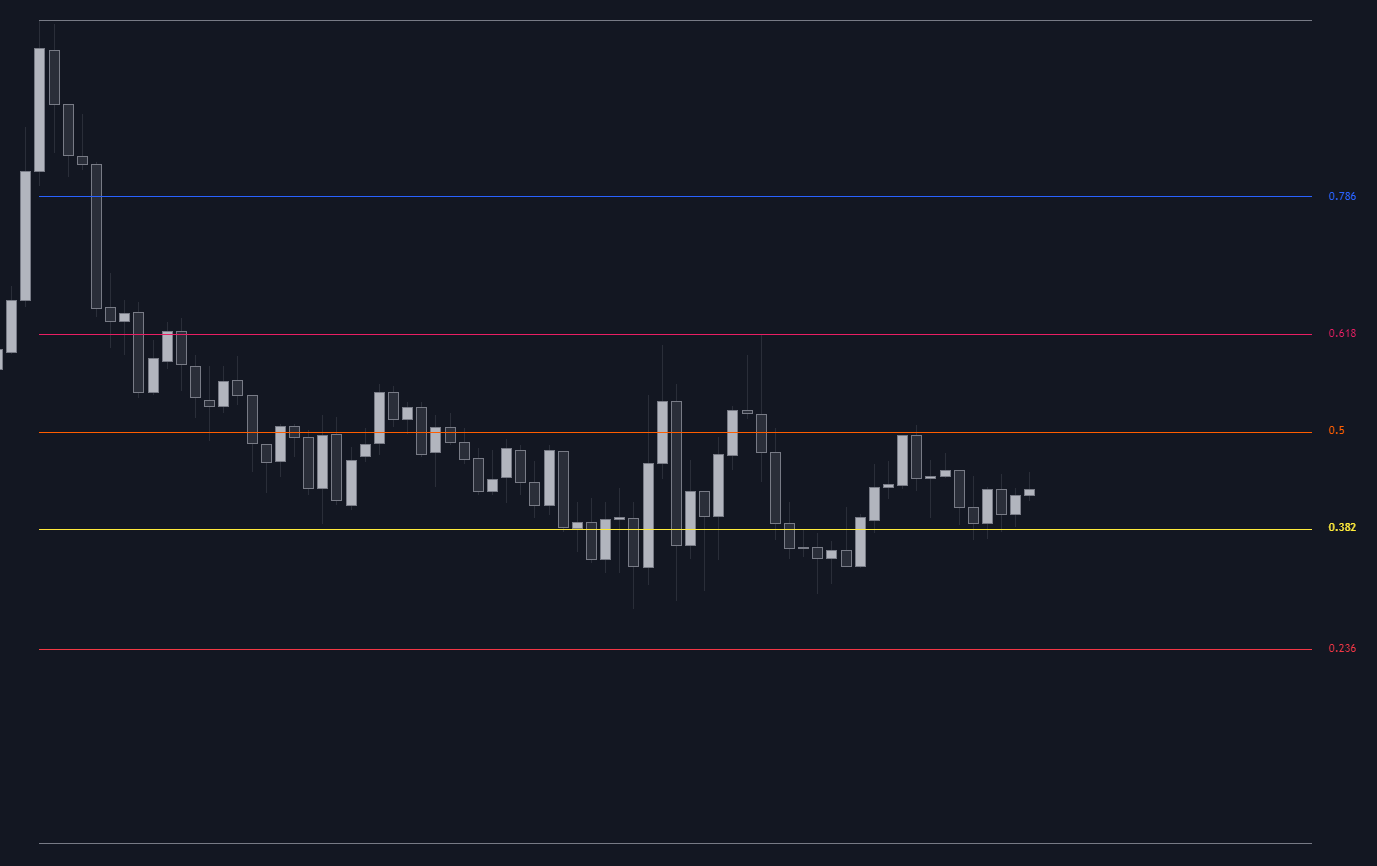Enhance your trading strategy with multi-timeframe analysis to identify trends, confirm signals, and manage risk effectively.
Multi-timeframe analysis is a trading technique that helps you make better decisions by analyzing market trends across different time periods. Here's a quick overview of the process:
-
Step 1: Select Timeframes
Use higher timeframes to identify trends, medium ones for confirmation, and lower timeframes for precise entries. Example combinations:- Swing Trading: Daily → 4-hour → 1-hour
- Day Trading: 1-hour → 15-minute → 5-minute
-
Step 2: Identify Trends and Key Levels
Spot trends with tools like moving averages and find support/resistance levels across timeframes for stronger setups. -
Step 3: Confirm Signals Across Timeframes
Use indicators (e.g., MACD, RSI) and candlestick patterns to validate signals on multiple timeframes. -
Step 4: Fine-Tune Entries
Refine entry points using Fibonacci retracements or trendlines on lower timeframes for better precision and risk control. -
Step 5: Manage Risk
Set position sizes and stop-losses based on multi-timeframe insights, ensuring alignment with overall trends.
Step 1: Selecting Timeframes
Choosing the right timeframes that match your trading style and objectives is crucial for accurate market analysis. The right selection helps you understand market movements across various time periods.
Types of Timeframes
Trading timeframes are generally grouped into three main categories, each serving a distinct purpose:
Long-term Timeframes (Daily, Weekly, Monthly)
- These charts highlight overall trends and critical price levels.
Medium-term Timeframes (4-hour, 1-hour)
- Ideal for swing trading, they help bridge broader trends with potential entry points.
Short-term Timeframes (15-minute, 5-minute, 1-minute)
- Perfect for pinpointing exact entries, especially for day trading or scalping.
Combining Timeframes for Better Analysis
Each trading style benefits from specific combinations of timeframes, allowing for a structured approach to trend analysis and trade entries:
| Trading Style | Primary Timeframe | Secondary Timeframe | Entry Timeframe |
|---|---|---|---|
| Swing Trading | Daily | 4-hour | 1-hour |
| Day Trading | 1-hour | 15-minute | 5-minute |
| Scalping | 15-minute | 5-minute | 1-minute |
For example, swing traders might use daily charts to identify trends, 4-hour charts to spot pullbacks, and 1-hour charts for precise entries. Day traders often rely on 1-hour charts for trend analysis, 15-minute charts for key levels, and 5-minute charts for entry points. Scalpers, on the other hand, use 15-minute charts for overall context, 5-minute charts for setups, and 1-minute charts for exact timing.
Tools like LuxAlgo indicators on TradingView can make multi-timeframe analysis easier. These tools help traders identify trends and patterns across different timeframes, making it simpler to spot areas where signals align (known as confluences).
Once your timeframes are selected, the next step is to analyze trends and key levels to prepare for your trades.
Step 2: Identifying Trends and Levels
After selecting your timeframes, the next step is to examine how trends and important levels interact across those timeframes. This analysis is crucial for pinpointing reliable trade entries.
Spotting Trends on Higher Timeframes
Higher timeframes help traders cut through short-term market noise and clearly define the overall direction. To identify trends effectively, use these technical tools:
- Moving Averages and Trendlines: Tools like moving averages (e.g., when shorter MAs cross above longer ones) and trendlines connecting major highs or lows are essential. On daily charts, these tools confirm the primary trend, while on 4-hour charts, they help refine your analysis by focusing on minor trendlines and shorter MAs.
For trendlines to be dependable, they should connect at least three significant highs or lows. This offers a clear visual of the market's direction and momentum.
Finding Support and Resistance
Pinpointing key support and resistance levels requires analyzing multiple timeframes. Levels that show up consistently across timeframes tend to carry more weight.

- How to Identify Key Levels: Look at previous highs and lows, psychological price levels (like round numbers), moving average intersections, and Fibonacci retracements.
LuxAlgo's tools can simplify this process by automating pattern recognition and multi-timeframe analysis, helping you quickly spot these levels.
Pay attention to zones where multiple technical factors align - these areas often represent stronger trading opportunities.
Once you’ve mapped out trends and levels, the next step is to validate signals across timeframes for more confident trade decisions.
Step 3: Signal Confirmation Across Timeframes
After identifying key trends and levels, it's crucial to confirm your trade entries using multiple signals across different timeframes. This step ensures stronger and more reliable setups.
Using Indicators to Confirm Signals
Combining technical indicators across various timeframes is a practical way to validate your trade decisions. Pay attention to these tools for better confirmation:
- Moving Average Crossovers: For instance, a bullish crossover on the daily chart gains more strength when similar crossovers appear on shorter timeframes.
- MACD and RSI: A bullish MACD crossover on a higher timeframe paired with an oversold RSI on a lower timeframe creates a more convincing setup.
Tools like LuxAlgo's Price Action Toolkit can make this process easier by automatically detecting indicator alignments across timeframes.
How Price Action and Candlestick Patterns Help
Price action and candlestick patterns are valuable for confirmation, especially when they align with signals from technical indicators. Their importance grows when analyzed across multiple timeframes.
Key Strategies for Price Action Confirmation:
- Start by identifying the trend direction on a higher timeframe.
- Ensure lower timeframe patterns, such as a bullish reversal, align with key levels like higher timeframe support.
Common Pitfalls to Avoid:
- Analyzing patterns without considering the broader context of higher timeframes.
- Jumping into trades before signals are fully aligned across your chosen timeframes.
Patience is key. Wait for clear confirmation across the timeframes you're analyzing. This practice often leads to better trade quality and improved risk-reward ratios.
Once you've confirmed signals across timeframes, you're ready to refine your entry points for greater precision and effective risk management.
Step 4: Fine-Tuning Entries
Once signals align across multiple timeframes, the next step is to fine-tune your entries. This ensures your trades are executed at the best possible price points, increasing the effectiveness of your trading setup.
Refining Entry Points
Lower timeframes are essential for determining the most accurate levels for trade execution. While higher timeframes highlight trading opportunities, shorter intervals help you zero in on the ideal entry price.
Ways to Refine Your Entries:
- Fibonacci Retracement Tools: Use these tools on lower timeframes to identify support and resistance levels where price reactions are likely.
- Trendline Analysis: Draw trendlines on lower timeframes to track short-term price movements and refine entry points in line with higher timeframe trends.

Tools like LuxAlgo's Price Action Toolkit can simplify this process by automatically identifying critical price levels and trendlines across timeframes, making it easier to optimize your entries.
Managing Risk with Precision
Using lower timeframes for entries allows for tighter risk management. This approach lets you set smaller stop-losses while maintaining strong risk-reward ratios. For instance, a setup on a 4-hour chart with a 50-pip stop-loss might be refined to just 30 pips on a 15-minute chart, improving trade efficiency.
Risk Management Advantages:
- Tighter stop-losses (e.g., 20-30 pips on 15-minute charts) improve risk-reward ratios, often achieving 1:3 or better.
- More precise entries reduce potential losses while preserving favorable risk-reward setups.
- Adjust stop-loss distances based on market volatility to avoid unnecessary risk.
Important Tips:
- Make sure your precise entries align with the overall market context to avoid overfitting.
- Choose entry timeframes that match current market volatility.
- Always stay in sync with higher timeframe trends for consistency.
With your entries fine-tuned, the next focus should be on implementing strong risk management strategies to safeguard your capital and maximize returns.
Step 5: Risk Management with Multi-Timeframe Analysis
Using multi-timeframe analysis can help protect your capital while aiming for better returns. Combining this approach with solid risk management can make your trading more consistent.
Setting Position Sizes and Stop-Losses
Multi-timeframe analysis can fine-tune how you size your positions. It gives you a clearer view of market conditions, especially during periods of high volatility, by layering insights from different timeframes.
Tips for Position Sizing:
- Base your initial position size on trends from higher timeframes.
- Adjust your position size according to the volatility seen on lower timeframes.
- Reduce your position size if shorter timeframes indicate heightened market turbulence.
When it comes to stop-losses, multiple timeframes can help pinpoint better levels. For instance, if a support level on a daily chart aligns with a price structure on a 4-hour chart, it offers a stronger and more reliable spot for placing your stop-loss.
Developing a Trading Plan
A trading plan that incorporates multi-timeframe analysis should clearly outline your entry, exit, and risk management strategies. It should also be flexible enough to adapt to changing market conditions.
Key Elements of a Trading Plan:
- Decide which timeframe combinations you’ll use for analysis.
- Set rules for position sizing based on the percentage of your account at risk.
- Define stop-loss and take-profit levels using confirmation across timeframes.
- Include guidelines for adjusting positions when market volatility shifts.
Risk Management Tips:
- Limit your risk to 1–2% of your total capital per trade.
- Adjust your position size if lower timeframes show more volatility.
- Use support and resistance levels from higher timeframes to confirm stop-loss placements.
- Check how different timeframes correlate before entering a trade.
Wrapping It Up
Once you’ve started using multi-timeframe analysis in your trading plan, the next step is to fine-tune your strategy and stick to it. This method improves how you time your trades and boosts reliability by giving you a clear picture of market behavior across different timeframes.
Key Takeaways
Multi-timeframe analysis helps build a solid trading strategy by aligning multiple perspectives. Following the five steps outlined in this guide with discipline is key to making it work.
Here are the main points to focus on:
- Choosing Timeframes: Pick timeframes that match your trading style and goals [1].
- Confirming Signals: Look for signals that align across timeframes to improve trade confidence [3].
- Managing Risk: Use information from all timeframes to set stop-loss levels and determine position sizes [1][4].
If you want to streamline your analysis, tools like LuxAlgo can help you spot trends and confirm signals across different timeframes.
Getting good at multi-timeframe analysis takes time and practice. Start with paper trading to test your approach without risking real money. Over time, you’ll get a better feel for how timeframes interact and how markets move [1][2].
LuxAlgo Price Action Concepts Screener
The LuxAlgo Price Action Concepts Screener can help you quickly identify trends and patterns on multiple timeframes. By scanning different markets simultaneously, it highlights potential confluences that align with your multi-timeframe analysis. This makes it easier to spot trade opportunities and avoid missing key setups that fit your strategy.
Learn more about how the screener works in the official documentation, or visit LuxAlgo Screeners to see its full range of features.

FAQs
Here are answers to some of the most common questions traders have about multi-timeframe analysis:
How many timeframes should I use?
The number of timeframes you use depends on your trading approach. For most traders, 2-3 timeframes work well:
- A higher timeframe to spot the overall trend
- A medium timeframe for confirmation
- A lower timeframe for fine-tuning entries
Using more than three timeframes can complicate decisions and slow down your trades. Tools like LuxAlgo can simplify this process by showing signal alignments across different charts.
What's the best timeframe combination for my trading style?
Here’s a quick reference for timeframe combinations based on trading styles:
| Trading Style | Primary Chart | Secondary Chart | Entry Chart |
|---|---|---|---|
| Position Trading | Weekly | Daily | 4-hour |
For swing trading or day trading combinations, check Step 1: Selecting Timeframes for more detailed examples.
How do I handle conflicting signals?
When signals don’t match up, give more weight to the higher timeframe. For instance, if the daily chart shows an uptrend but the 1-hour chart indicates a pullback, stick with the daily chart's trend. Wait until the signals align before entering a trade to avoid unnecessary risks.
Can I automate multi-timeframe analysis?
Yes, tools like LuxAlgo can automate parts of the process by spotting potential setups for you. That said, you’ll still need to use your own judgment for final decisions to ensure you account for the full context and manage risk effectively.
References
- https://www.luxalgo.com/library/indicator/Support-Resistance-Dynamic/
- https://en.wikipedia.org/wiki/MACD
- https://www.investopedia.com/terms/r/rsi.asp
- https://www.luxalgo.com/library/indicator/Candlestick-Structure/
- https://en.wikipedia.org/wiki/Fibonacci_retracement
- https://www.luxalgo.com/blog/the-best-indicator-settings-timeframes-a-silver-bullet/
- https://www.luxalgo.com/
- https://www.tradingview.com/
- https://app.luxalgo.com/library/indicator/Support-Resistance-Dynamic/
- https://docs.luxalgo.com/docs/luxalgo-toolkits/price-action-concepts/fibonacci
- https://www.luxalgo.com/blog/t/technical-indicators/
- https://docs.luxalgo.com/docs/toolkits/price-action-concepts/fibonacci
- https://www.luxalgo.com/library/indicator/Trend-Lines/
- https://app.luxalgo.com/library/indicator/Liquidation-Levels/
- https://www.litefinance.org/blog/for-beginners/trading-strategies/trading-3-time-frames/
- https://goelasf.in/blog/top-5-strategies-for-multi-timeframe-analysis/
- https://www.topdogtrading.com/multiple-time-frame-trading-methodology/
- https://www.rebelsfunding.com/benefit-multiple-timeframe-analysis-trading/
- https://docs.luxalgo.com/docs/screeners/pac/introduction
- https://www.luxalgo.com/features/screeners/







